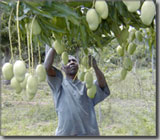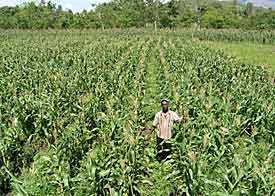The key goals of our development projects in Haiti are to increase farmer income, produce nutritionally enhanced food, and to improve the environment with commercial fruit trees. The benefits are economic, environmental and nutritional.
Program benefits
The benefits can in simple terms be described as follows: economic because of the income they generate; environmental through long-lasting ground-cover from trees and perennial crops; and nutritional from nutritionally enhanced staple crops and more abundant food supplies.
Fruit trees, improved staple crops and vegetables are some of the most lucrative crops for farmers.

A grafted fruit tree costs about $5 to produce. The yields increase after about 4 years to $50-100 a year per tree over a 35-50 year period.
Income from tree crops
The highest revenue crops are commercial
fruit trees such as export quality Madame Francis mangoes, late season Choquette
avocados and the Jacmel variety mandarins. Income generated by these commercial
varieties are strikingly higher than from low quality fruit and forestry trees,
which derive little value as wood.
Export quality mangoes, out-of-season avocados and mandarins are some of Haiti's most lucrative crops, earning up to $100 a year per tree. The international market for tropical fruits is far from saturated - so fruit trees offer an interesting economical solution to the country's degraded environment. The economic value of the fruit guarantee long-term beneficial effects on the environment for many decades to come.
 Improved
corn seeds average about 50% profit.
Improved
corn seeds average about 50% profit.
Habanero hot peppers earn farmers $0.30/lb.
Reinforcing the environment with commercial fruit tree crops and bamboo
Since 1985, ORE has produced over a million grafted fruit trees in Haiti. By promoting fruits and other commercial tree crops, experience shows that in time communities start to protect their trees because of the attractive revenue they generate. By providing improved seeds, soil conservation measures, and offering production and marketing assistance, we are able to help the farmers replace subsistence farming with commercially successful agriculture. Increased income from fruit trees producing annual commercial crops helps to remove the economic pressure on local ecosystems. In regions where the program has been able to create concentrated regional fruit production, farmers are beginning to look on orchards of mangos, avocados and citrus as investment opportunities. The ecological impact is clearly visible, the tree cover is increased and soil erosion are reduced. Fruit trees, spices, high value bamboo, suitable for construction and handicrafts, soil conservation measures and leguminous trees such as Calliandra (used as pole for yam production) all add up to a powerful environmental protection package - offering farmers cost-effective solutions that will help preserve the ecology for future generations.

Quality Protein Maize
ORE is currently producing a high-protein, high-yielding variety of corn to help alleviate malnutrition in Haiti. Quality protein maize, or "QPM", originally developed at CIMMYT in Mexico in the late 1990s, contains nearly twice as much usable protein as other maize grown in the tropics and yields substantially more grain than traditional corn. 100 gms of QPM corn has 338.2 kcal of Food Energy and 9.91 gms of protein.
Other nutritionally-enhanced food crops ORE is propagating include beans with more iron and zinc in Guatemala, and vitamin A-rich sweet potato in Haiti.
Extending the avocado season: Avocado is one of the highest calorie fruits. It is high in protein, vitamins and other nutrients ORE is working with varieties such as Choquette and Lula that bear fruit between December and March, and thereby extend the production season by four months. By combining early and late season varieties it is possible to extend the production season to ten months of the year.
Mangos: ORE has also introduced late season mango varieties such as the Zill Late which helps to extend the already exceptionally long vitamin-rich mango production through most of the year.
Citrus: Citrus varieties such as the Tangelo, which ORE introduced in the 1980s and propagated in huge quantities, tend to bear fruit throughout the year, providing a year-round source of vitamin C.
Support our efforts to improve nutrition in rural Haiti



